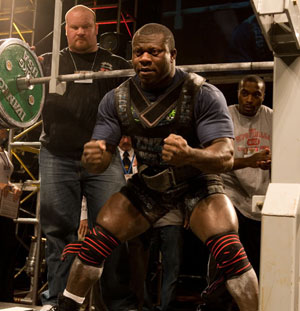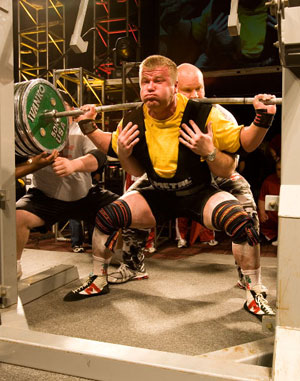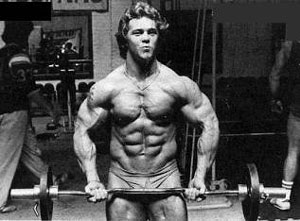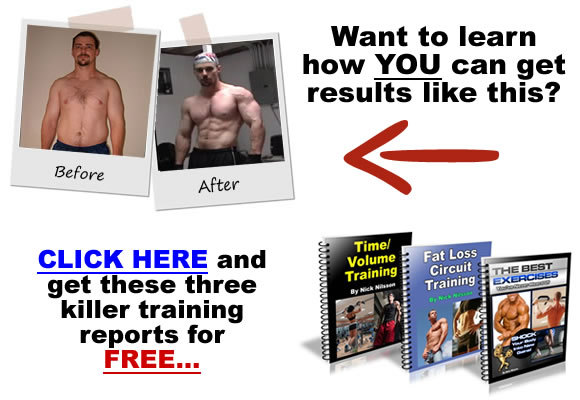|
 This is one of THE best overall abdominal/core exercises I've EVER found. If you want a stronger core and you want it fast, THIS is the exercise to focus on. It's tough, but VERY effective.
This is one of THE best overall abdominal/core exercises I've EVER found. If you want a stronger core and you want it fast, THIS is the exercise to focus on. It's tough, but VERY effective.
The Curl Squat exercise is deceptively simple...basically, you're going to do a squat while holding the barbell in the top of the barbell curl position. That's it!
So what makes this exercise different from a front squat (where you support the weight across the front of your shoulders)? And what makes is so EXTREMELY effective for training the core (which is the REAL reason for doing this particular exercise, NOT for working the legs)?
I'll tell you!
Holding the resistance in front of your body in the top curl position takes away the shoulder support that you would normally get with a front squat. ALL the supporting tension goes directly onto the muscles of the core, instead of having much of it being taken up by the shoulders. ALL your core muscles will have to contract HARD throughout the entire movement in order to keep the barbell from falling forward.
The difference in position may seem subtle, but it's tension that you have to experience to believe!
This exercise also helps you to get a feel for how to properly use the abs during a squat, which is EXTREMELY important for maximizing your squat strength. Using the abs while squatting (especially at the bottom of the lift) is something that does not come naturally and is very rarely taught or explained to trainers. And believe me, it has the potential to add pounds to your squat FAST.
Another great benefit to this exercise is that your breathing muscles (the intercostals) NEVER get a chance to relax during this movement. From top to bottom and back up (even while you're "resting" at the top), your breathing muscles are being challenged because of the weight they're being forced to support.
This can build up great breathing strength (the term "breathing strength" may sound strange but watch a strongman explode a hot water bottle just by inflating it with lung power and you'll know what I'm talking about!) and carries directly over to your work capacity in the regular barbell squat as well as most other demanding exercises and sports!
How To Do It:
To do this exercise, all you really need is a barbell, but if you have access to a power rack, even better. The rack will make it easier to get into position for the exercise and will serve to "catch" the bar when you're done.
 Set the rack up so that the racking pins are one notch below where you would normally set them for squats. The reason you want to set those pins one notch below is that by the time you're done with the exercise, it may be very hard to get the bar up to the height where you would normally rack the bar! With the racks a little lower, you'll have an easier time getting the bar back onto them.
Set the rack up so that the racking pins are one notch below where you would normally set them for squats. The reason you want to set those pins one notch below is that by the time you're done with the exercise, it may be very hard to get the bar up to the height where you would normally rack the bar! With the racks a little lower, you'll have an easier time getting the bar back onto them.
Set the safety rails just above where you normally set them for regular squats the first time you try this. When you develop a better feel for how it's done, you can lower them a little to get the full range of motion.
The weight should be about the same as what you would use for barbell curls for about 8 to 10 reps. This is a starting point - you can add weight as you get stronger with the exercise.
Step in front of the bar and hold it in the top position of the barbell curl. Now stand up, unracking the bar. Don't allow your elbows to brace against your midsection. This will take away from the supporting tension on the abs. Take a step back and get your feet set.
Now, holding the bar in that top curl position through the entire movement, squat down as far as you can then come back up. You don't actually curl the bar while doing the squat, you just hold it in the top curl position.
To increase abdominal stability, you will be holding your breath during parts of this movement. As you start to lower yourself down, inhale. Begin holding your breath just below the halfway point of the squat as you come down to the bottom position. Continue to hold it until you're about 1/4 to 1/2 of the way back up.
If you don't want to or are unable to hold your breath, exhale through pursed lips (as though you're blowing up a balloon). Keeping the breath held towards the bottom will maximize core stability and allow your abs to function more effectively during the movement. Since this exercise uses relatively light weight compared to a regular squat, holding your breath is not nearly as potentially dangerous.
That being said, if you DO feel lightheaded at any point in the exercise, rack the bar and rest. Always use your best judgement here. The idea is to work yourself in a SAFE manner.
When doing the exercise for the first time, it's a good idea to start with just the bar, no matter how strong you are. This will help you get a feel for how the movement is done, where to set the safety rails and how far down you can comfortably go.
When you're comfortable, work your way up slowly from there as fatigue will come quickly. It's a movement your body will be totally unused to, no matter how many abdominal exercises you've done in your training career before this. The muscles of the core will tire before your legs do. Be sure to keep your lower back arched and tight while performing this movement.
 If you're able to, go all the way down until your elbows touch your knees. This will give you the fullest range of motion. Tense the abs hard, especially at the bottom as you're coming back up. For extra resistance, pause at the bottom for a few seconds. This will give you the best feel for how the abs should be used when squatting.
If you're able to, go all the way down until your elbows touch your knees. This will give you the fullest range of motion. Tense the abs hard, especially at the bottom as you're coming back up. For extra resistance, pause at the bottom for a few seconds. This will give you the best feel for how the abs should be used when squatting.
With this exercise, having the resistance in front of the body (similar to when you're doing a front squat) allows you to keep a more vertical body position. The majority of the tension WILL go onto the abs, but be aware that there will also be some tension going to the lower back.
Because you're holding the weight out in front of you, the lower back must also contract to help stabilize the spine. As you keep up with the exercise, your lower back will get stronger.
COMMON ERRORS
1. Doing this exercise after a bicep workout
As you can imagine, performing this exercise is not going be as effective if you've just finished a bicep workout. The biceps will already be fatigued and you'll limit the amount of weight you can use and how long you can hold it for. Use this exercise on non-bicep training days, if possible.
2. Going too fast
Dropping down quickly in the squat will put extra stress on the biceps as you come up and reduce the tension on the abs. This exercise should be done very deliberately with no bouncing or fast movements. If you have a tendency to do this, pause at the bottom for a few seconds to stop the bouncing.
3. Using too much weight
Since the legs are so much stronger, it's tempting to use too much weight for this exercise. Remember, our goal here is NOT to work the legs or the biceps but to work the abs. The legs and the biceps are only here to help push the abs. If your biceps fatigue before your abs get a good workout, you need to reduce the weight.
4. Leaning forward
Try to keep your upper body as vertical as possible with this one. It's very similar to a front squat - having the weight in front of you allows you to stay vertical more easily. Leaning forward will cause the barbell to shift forward, which will put more tension on the biceps, causing them to fatigue prematurely. As you start to fatigue, you will notice you have a tendency to lean forward. This is because the supporting abs are weakening. Do your best to keep vertical. Once you start to move too far forward, end the set.
5. Bar too close to chin
If the bar gets too close to the collarbones, you will lose some of the tension in the abs. Keep it at least a few inches away to maximize the supporting tension and torque demanded of the abs. If it comes too close, it may be tempting to rest the bar on your collarbones, which will turn it into an uncomfortable front squat.
6. Letting the elbows brace strongly against the midsection
If you let the elbows press strongly into the midsection, it will take away some of the tension on the abs. A little contact is fine, especially as you get tired, but don't rely on using this technique or it will make the exercise less effective.
Letting the elbows sink in like this will also tend to hunch your back over, putting pressure on the lower back. This will in turn pull your torso and center of balance forward, putting more tension on the biceps, making you dig the elbows in more! Keep the elbows out front, away from your body and you'll keep a better body position and do a more effective set.
TRICKS
1. Look forward and slightly up
When you squat, keeping looking forward and slightly up. This will help you to keep an arch in your lower back and keep you from leaning forward. We want to avoid forward lean as it causes the biceps to fatigue prematurely.
2. Don't breathe too deeply in or out as you're coming down or pushing back up
Breathing too much during this exercise reduces core stability and can compromise your form. For best core stabilization, keep your breath carefully controlled. At the bottom, you can hold your breath for a few moments to get the most solid stability. As you come up, you can exhale through pursed lips after you've come about 1/4 to 1/2 of the way. This technique shouldn't be used if you have blood pressure issues, however, as it does cause an increase in blood pressure. Keep a careful eye on how you feel if you do choose to do this - and if you feel any dizziness, end the set and then don't use this technique the next set.
3. Pause at the bottom
To really maximize the tension on the abs, pause for a few seconds at the bottom and focus on really squeezing and tightening your abs hard. As you start to come back up, try to push with your abs as well. This will help you to feel what it's like to use the abs to help push out of the bottom when doing regular barbell squats.
CONCLUSION:
If you're serious about improving core strength, DEFINITELY add this exercise to your list. It simply one of THE most effective core strength exercises I've ever found, and will provide you with dramatic increases in abdominal stability and strength.

More Articles by Author Nick Nilsson
Return To Weight Lifting Articles Archive
|